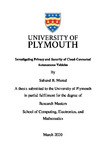Investigating Privacy and Security of Cloud-Connected Autonomous Vehicles
| dc.contributor.supervisor | Khan, Asiya | |
| dc.contributor.author | Murad, Sahand B. | |
| dc.contributor.other | School of Engineering, Computing and Mathematics | en_US |
| dc.date.accessioned | 2021-06-25T13:37:16Z | |
| dc.date.available | 2021-06-25T13:37:16Z | |
| dc.date.issued | 2021 | |
| dc.identifier | 10589924 | en_US |
| dc.identifier.uri | http://hdl.handle.net/10026.1/17280 | |
| dc.description.abstract |
Autonomous cars are intelligent systems that can do Physical tasks without human interaction and are used in Industrial environments, transport, and the military, one of most powerful feature of this technology is that possess intelligent agents that can learn from their environment, furthermore, they have several sensors with connectivity between them. Nowadays most of the car manufacturer use autonomous features like lane-keeping, Adaptive Cruise Control (ACC), advance driver assistance system and automatic parking system resulting in a rapid increase in research of autonomous vehicles e.g. in 2004 and 2005 DARPA challenges for vehicles to autonomously navigate via desert terrain, moreover, the DARPA challenge in 2007 developed and tested cars that independently explored via a mock urban condition amid traffic. Vehicles have huge potential in improving road safety, providing convenience; reducing emissions and congestion by communicating with another vehicle within the same network furthermore, in case of emergency they can also notify other vehicles of the incident. Much architecture for communication between vehicles is centralized, typically using cloud servers. The security and trust of that communication are paramount. Therefore, this research aimed to propose a novel method that can insure data security in the cloud by encrypting and fragmenting data to increase the uncertainty for an attacker so as a result, it becomes difficult for hackers to compromise the confidentiality and integrity of data residing in the cloud. This research presents experimental results in terms of time, CPU utilization and size which allowed to determine the most effective method for securing data in the cloud and hence making it difficult for a hacker to reconstruct data. Splitting and encrypting different size of video and text file or encrypting the whole file shows that less time, CPU usage and size is taken in splitting and encrypting 5KB rather than other sizes or encrypting the whole file, so it saves CPU utilization, time and storage, hence, it is the ideal size as it minimizes the CPU resources and memory as compared to different size fragments. The privacy of data is at a higher level preventing a hacker from accessing the data as it is shared in multiple clouds, furthermore, the proposed technique also proposed a mechanism which ensures the data integrity and confidentiality by encrypting the data header hence making it almost impossible for hacker to reconstruct the original data even if it been hacked by man in middle attack. Finally, the experimental results shows that this method can overcome the issue of overhead in transmission and as a result, makes it an efficient and effective mechanism to encounter the data security problem. | en_US |
| dc.language.iso | en | |
| dc.publisher | University of Plymouth | |
| dc.rights | CC0 1.0 Universal | * |
| dc.rights.uri | http://creativecommons.org/publicdomain/zero/1.0/ | * |
| dc.subject | Sensors | en_US |
| dc.subject | Encryption | en_US |
| dc.subject | Cameras | en_US |
| dc.subject | Pins | en_US |
| dc.subject | Autonomous Vehicle | en_US |
| dc.subject.classification | ResM | en_US |
| dc.title | Investigating Privacy and Security of Cloud-Connected Autonomous Vehicles | en_US |
| dc.type | Thesis | |
| plymouth.version | publishable | en_US |
| dc.identifier.doi | http://dx.doi.org/10.24382/1055 | |
| dc.rights.embargoperiod | No embargo | en_US |
| dc.type.qualification | Masters | en_US |
| rioxxterms.version | NA | |
| plymouth.orcid_id | 0000-0002-2934-825X | en_US |
Files in this item
This item appears in the following Collection(s)
-
01 Research Theses Main Collection
Research Theses Main



